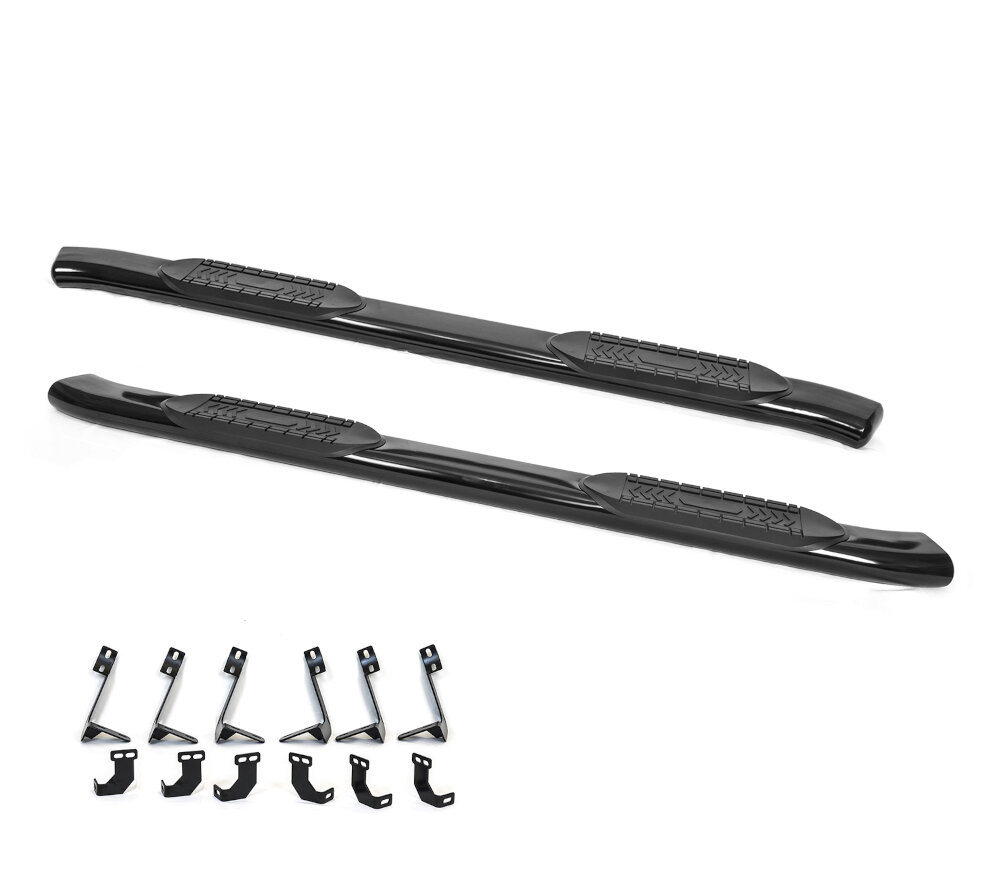Blue Lock Tight for Installing Running Boards: Is It Necessary?

When it comes to installing running boards on your vehicle, there are many factors to consider. One of the most important of these is the type of adhesive or locking mechanism that you should use. Blue Lock Tight is a popular option that many people turn to, but the question remains: is it necessary? In this article, we will explore the benefits and drawbacks of using Blue Lock Tight for installing running boards and help you make an informed decision about whether it is right for your needs. Blue Lock Tight is a type of threadlocker that is designed to keep screws and bolts securely in place. It is commonly used in automotive applications, including the installation of running boards. The product is designed to prevent fasteners from loosening over time, which can cause damage to your vehicle and compromise your safety. However, some people question whether Blue Lock Tight is really necessary for installing running boards and whether there are other options that can provide the same level of security. In the following sections, we will take a closer look at the pros and cons of Blue Lock Tight and help you decide whether it is the right choice for you.
Running boards are a type of accessory that is attached to the side of a vehicle, particularly trucks and SUVs. They are designed to provide a step-up platform for passengers to get into the vehicle easily. These boards are typically made of metal or plastic and are available in different lengths and styles. Running boards are a popular addition to vehicles because they enhance the appearance of the vehicle and add functionality, making it easier for passengers to enter and exit the vehicle. However, installing them can be a challenging task, which is why many people use Blue Lock Tight to ensure they are securely attached to the vehicle.
The installation process of running boards is a relatively straightforward procedure and can be completed with basic tools and moderate mechanical knowledge. To begin, the vehicle’s undercarriage is cleaned to ensure a secure bond with the running boards. Next, the brackets are mounted onto the vehicle, and the running boards are positioned onto the brackets. Once the running boards are properly aligned, the bolts are tightened to secure the running boards in place. It is recommended to apply a thread locker, such as Blue Lock Tight, to the bolts to prevent them from loosening over time. The installation process may vary depending on the make and model of the vehicle, but generally, it takes a few hours to complete.
What is Blue Lock Tight?

Blue Lock Tight is a type of threadlocker adhesive that is commonly used in automotive applications. It is a specialized adhesive that is designed to prevent bolts, screws, and other fasteners from loosening due to vibrations or other external forces. This adhesive works by creating a strong bond between the threads of the fastener and the material that it is being screwed into. This bond helps to prevent the fastener from backing out or becoming loose over time. Blue Lock Tight is a popular choice for installing running boards on vehicles because it helps to ensure that the fasteners will remain secure over the long term. When installing running boards on a vehicle, it is important to use a high-quality adhesive like Blue Lock Tight to ensure that the fasteners remain secure. Running boards are typically subjected to a lot of vibration and jostling as the vehicle moves down the road. This can cause the fasteners to loosen over time, which can be dangerous for both the driver and passengers. By using Blue Lock Tight, installers can help to prevent this from happening and ensure that the running boards remain securely attached to the vehicle. Overall, Blue Lock Tight is an important tool for anyone who is installing running boards or other automotive accessories and wants to ensure that they remain secure and safe over the long term.
Blue Lock Tight is a type of adhesive that is commonly used in industrial and automotive applications. This substance works by creating a strong bond between two surfaces, preventing them from coming apart. The adhesive is applied to the threads of bolts or screws before they are inserted into the designated holes. Once the bolts are tightened, the Blue Lock Tight hardens, creating a secure and permanent connection between the two surfaces. This feature makes it a popular choice for installing running boards, as it ensures that they remain firmly in place, even when subjected to regular use. The use of Blue Lock Tight is not always necessary, but it can provide an added layer of security and peace of mind for those who want to ensure their running boards stay put.
Using Blue Lock Tight for installations can provide numerous benefits, particularly when it comes to installing running boards on vehicles. This type of adhesive is designed to prevent screws and bolts from loosening over time, which is especially important for parts that are exposed to constant vibrations and movement. By using Blue Lock Tight, you can ensure that the running boards remain securely in place, reducing the risk of damage or accidents. Additionally, this adhesive is resistant to water, gasoline, and other common automotive fluids, making it a durable and reliable choice for all types of vehicles. Overall, if you want to ensure that your running boards are installed properly and securely, using Blue Lock Tight is a smart choice.
Blue Lock Tight is a type of adhesive that is commonly used for securing nuts, bolts, and screws in place. There are several different types of Blue Lock Tight available, each with its own specific uses. For example, low-strength Blue Lock Tight is ideal for applications where parts need to be disassembled frequently, while medium-strength Blue Lock Tight is better suited for applications where a moderate amount of force is required to disassemble parts. High-strength Blue Lock Tight is the most secure option, offering a permanent bond that is difficult to break. When installing running boards on a vehicle, it is generally recommended to use a medium-strength Blue Lock Tight to ensure that the bolts holding the boards in place remain secure over time.
Why Use Blue Lock Tight for Running Board Installations?

When it comes to installing running boards on your vehicle, it’s important to ensure that they are securely fastened. One way to achieve this is by using Blue Lock Tight. This type of locking adhesive can help to prevent bolts from coming loose over time, even in situations where there is a lot of vibration or movement. By using Blue Lock Tight, you can be confident that your running boards will stay in place and won’t pose a safety risk while you’re driving. Using Blue Lock Tight is particularly important if you plan to use your vehicle for off-road driving or other activities that involve a lot of bumps and jolts. In these situations, it’s even more crucial to make sure that your running boards are securely attached. Blue Lock Tight can help to prevent bolts from loosening, which can cause the running boards to shift or even fall off completely. This can be dangerous, not only for you and your passengers but also for other drivers on the road. By taking the extra step to use Blue Lock Tight during the installation process, you can ensure that your running boards will stay firmly in place no matter what challenges you encounter on the road.
Blue Lock Tight is a necessary component when it comes to installing running boards on your vehicle. This specially formulated adhesive is designed to ensure that the nuts and bolts that secure the running boards to the underside of your vehicle stay in place. Without this adhesive, the nuts and bolts could easily become loose due to the vibrations and jolts that come with driving. Loose running boards not only pose a safety risk, but they can also cause damage to your vehicle. Blue Lock Tight is a highly effective threadlocker that prevents loosening and ensures that your running boards remain securely attached to your vehicle’s frame. So, if you want to ensure a safe and secure installation, Blue Lock Tight is definitely a necessary addition to your running board installation kit.
Preventing loosening and vibration is crucial in ensuring the safety and longevity of any installation. In the case of running boards, loose bolts or nuts can lead to the board shifting or even falling off during use, posing a serious hazard to the driver and passengers. Vibrations can also cause wear and tear on the installation and the surrounding components, leading to premature failure. This is where products like Blue Lock Tight come in. By providing a secure and reliable bond between the bolts and nuts, Blue Lock Tight can effectively prevent loosening and vibration, ultimately ensuring the safety and durability of the running board installation.
Compared to other methods of securing running boards, the use of Blue Lock Tight presents several advantages. While some may opt for standard bolts or screws, these can become loose over time due to vibration and exposure to the elements, resulting in potential safety hazards. Alternatively, some may use welding to attach running boards, which is a more permanent solution but can be costly and limit the ability to easily remove and replace the boards. Blue Lock Tight offers a middle ground, providing a secure and durable hold without the need for welding and allowing for easy removal if necessary. It also ensures that the bolts do not become loose over time, providing added safety and peace of mind for the driver and passengers.
How to Use Blue Lock Tight for Running Board Installations

When it comes to installing running boards, many people wonder whether they need to use Blue Lock Tight. The answer is yes, it is necessary. Blue Lock Tight is a type of adhesive that is specifically designed to secure bolts and nuts in place. When you install running boards, you want to make sure that they are securely attached to your vehicle. If the bolts and nuts become loose, the running boards can move around, which can be dangerous and cause damage to your vehicle. By using Blue Lock Tight, you can ensure that the bolts and nuts will stay in place, providing a secure and safe installation. To use Blue Lock Tight for running board installations, you will need to follow a few simple steps. First, make sure that the bolts and nuts are clean and free of any debris. Apply a small amount of Blue Lock Tight to the threads of the bolt, making sure to cover the entire thread. Then, insert the bolt into the hole and tighten it with a wrench. Repeat this process for all of the bolts and nuts. Once you have tightened all of the bolts and nuts, let the Blue Lock Tight dry for at least 24 hours before driving your vehicle. By following these steps, you can ensure that your running board installation is secure and safe.
When installing running boards, it is imperative to use Blue Lock Tight to ensure that the bolts remain secure and do not loosen over time. To apply Blue Lock Tight, first, ensure that the threads of the bolts are clean and free of any debris. Then, place a small drop of the Blue Lock Tight onto the threads of each bolt. Use a wrench to tighten the bolts to the recommended torque specifications. Allow the Lock Tight to dry for at least 24 hours before driving or putting weight on the running boards. Blue Lock Tight is a high-strength adhesive that prevents vibration, corrosion, and loosening of bolts. It is crucial to use this product when installing running boards to ensure the safety of the driver and passengers.
When it comes to installing running boards on your vehicle, using a blue lock tight adhesive can provide added security and stability. However, it is important to use the adhesive properly to ensure safe and effective installation. Before applying the adhesive, make sure the surface is clean and free of any debris or oil. Apply a small amount of the adhesive to the bolts or screws and tighten them securely. It is also important to follow the manufacturer’s instructions for proper curing time and torque specifications. Using too much adhesive or not allowing enough time for it to cure can result in a weakened bond and potentially dangerous situation. By following these tips, you can ensure a proper application and usage of blue lock tight for installing running boards on your vehicle.
When installing running boards, it is essential to take necessary precautions and safety measures to ensure a secure and safe installation process. Before beginning any installation, always read the instructions and follow them carefully. Wear protective gear such as gloves and safety goggles to prevent any injury. Make sure to work on a level surface and use appropriate tools. Additionally, if using a blue lock tight adhesive, it is important to follow the manufacturer’s instructions and apply it in a well-ventilated area. Taking these precautions and safety measures can help prevent any accidents and ensure a successful installation process.
When it comes to installing running boards, using Blue Lock Tight is not only necessary but also highly beneficial. This powerful adhesive offers numerous advantages that make it an ideal choice for securing running boards in place. Firstly, Blue Lock Tight provides a strong and secure hold that is resistant to vibration, shock, and temperature changes, ensuring that the running board remains firmly attached to the vehicle. Additionally, Blue Lock Tight is easy to apply and dries quickly, which means that installation can be completed quickly and efficiently. This adhesive is also resistant to water, oil, and other automotive fluids, which helps to protect the running board from corrosion and damage. In summary, using Blue Lock Tight for running board installations is essential for ensuring a safe and secure fit that will last for years to come.
In conclusion, Blue Lock Tight can be a useful product for those installing running boards on their vehicles. It provides an extra layer of security and prevents the bolts from loosening over time. However, it is important to use it sparingly and only on areas where vibration and movement are a concern. Overuse of Blue Lock Tight can make it difficult to remove the bolts in the future. Additionally, it is essential to follow the manufacturer’s instructions carefully and apply it in a well-ventilated area. Overall, if you want to ensure your running boards remain secure for years to come, Blue Lock Tight is worth considering, but be sure to use it correctly and with caution.
Conclusion

In conclusion, the use of blue lock tight for installing running boards is highly recommended. While some may argue that it is not necessary, the benefits of using this thread locker far outweigh any potential drawbacks. Blue lock tight provides a secure and long-lasting bond between the running board and the vehicle, preventing any unwanted movement or loosening of the bolts. Additionally, its ability to withstand extreme temperatures and vibrations make it an ideal choice for automotive applications. Overall, using blue lock tight for installing running boards is a wise investment that will ensure the safety and stability of the vehicle for years to come.

